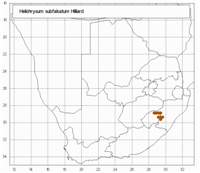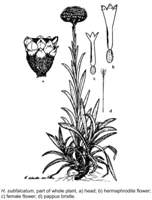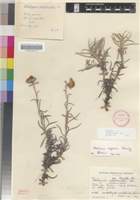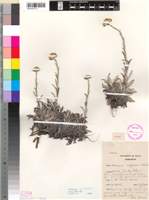Origin of name:
sub = somewhat not complete.falcatus = curved like a sickle, falcate
Diagnostic characters:
Long linear leaves, bicoloured, margins rolled underCompact flower heads on short leafy stalks
Description:
Mat-forming perennial herb, main stems branching, prostrate, rooting, producing numerous congested leaf rosettes, flowering stems terminal, 10-200 mm long, simple, distantly leafy upwards. Leaves 30-60 x 2-7 mm, generally narrowly lanceolate, rarely linear, often conduplicate and slightly falcate, apex acute, base broad, clasping, indumentum smooth, sericeous, stripping like tissue-paper, upper surface green drying grey, lower silvery white. Heads heterogamous, cylindric, c. 4 x 3 mm, many webbed together in a congested terminal cluster 15-20 mm across. Involucral bracts in c. 3 series, subequal, loosely imbricate, equaling the flowers, translucent, outer brownish, all tipped bright canary-yellow, obtuse, not radiating. Receptacle shortly honeycombed. Flowers c. 10-17, 2-4 female, 7-14 homogamous, yellow. Achenes 0.75mm long, with myxogenic duplex hairs. Pappus bristles 3-5, tips shortly plumose, bright yellow, shaft nude, bases not cohering.
Flowering between January and March.
Distribution:
Grows on steep stony mountain slopes and tops, often in large colonies. Recorded along the KwaZulu-Natal Drakensberg from the headwaters of the Umzimkulu (Mashai Pass and Wilson's Cave area) and Sani Pass, all in Underberg district, to Mont aux Sources, Bergville district, c. 2 100 to 3 200 m.
Grassland Biome.
Taxonomy:
Literature:
Helichrysum subfalcatum Hilliard in Notes R. bot. Gdn Edinb. 32: 361 (1973), Compositae in Natal 163 (1977).
Type:
KwaZulu-Natal, Estcourt distr., Highmoor Forest Reserve, spur running E. from Giant's Castle, c. 8000 ft., Hilliard 4809 (NU, holo.; E, iso.).
Synonym(s):
Vouchers:
Hilliard 4815 (E; K; NU; PRE); Schelpe 1387 (NU); Wright 383 (E; K; M; NU; S); Killick & Vahrmeijer 3733 (PRE).



